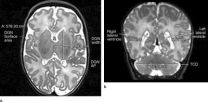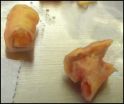(Press-News.org) OAK BROOK, Ill. – Babies born 32 to 36 weeks into gestation may have smaller brains and other brain abnormalities that could lead to long-term developmental problems, according to a new study published online in the journal Radiology.
Much of the existing knowledge on preterm birth and brain development has been drawn from studies of individuals born very preterm, or less than 32 weeks into gestation at birth.
For the new study, researchers in Australia focused on moderate and late preterm (MLPT) babies —those born between 32 weeks, zero days, and 36 weeks, six days, into gestation. MLPT babies account for approximately 80 percent of all preterm births and are responsible for much of the rise in the rates of preterm birth over the last 20 years. Despite this, to date there have been no large-scale studies published on brain alterations associated with MLPT birth that may provide insight into brain-behavior relationships in this group of children.
"In those very preterm babies, brain injury from bleeding into the brain or a lack of blood flow, oxygen or nutrition to the brain may explain some of the abnormal brain development that occurs," said the study's lead author, Jennifer M. Walsh, M.B.B.Ch., B.A.O., M.R.C.P.I., from the Royal Women's Hospital in Melbourne, Australia. "However, in some preterm babies, there may be no obvious explanation for why their brain development appears slow compared with babies born on time."
To learn more, the researchers performed magnetic resonance imaging (MRI) exams on 199 MLPT and 50 term-born infants (greater than 37 weeks gestation) between 38 to 44 weeks of gestation. They looked for signs of brain injury and compared the size and maturation of multiple brain structures in the two groups.
While injury rates were similar between the two groups, MLPT birth was associated with smaller brain size at term-equivalent age. In addition, MLPT infants had less developed myelination in one part of the brain and more immature gyral folding compared with term-born controls. Myelination—the formation of a fatty insulating sheath around some nerve fibers—and gyral folding—the folding of the cerebral cortex to increase the brain's surface area—are important processes in early brain development.
The findings suggest that MLPT birth may disrupt the expected trajectory of brain growth that would normally occur in the last two or so months in utero, according to Dr. Walsh.
"Given that brain growth is very rapid in the last one-third of pregnancy, it is perhaps not surprising that being born during this potentially vulnerable period may disrupt brain development," she said. "Brain growth is very complex, involving not only the neurons with which we think and do things, but also the other brain cells that support the neurons and are vital for normal brain function."
The researchers are hoping to learn in greater depth the impact that moderate to late preterm birth has on the brain, so that they can then begin to try different treatments designed to improve brain function and long-term outcome in these infants.
"Medications, along with early intervention to help parents understand their baby's needs, have been effective in helping very preterm babies catch up to their term-born peers," Dr. Walsh said. "However, whether any of the existing treatments will help babies born between 32 and 36 weeks is unknown, as they have not been studied very much at all."
The researchers plan to follow the infants in the study group through childhood to learn more about the relationship between brain abnormalities and later outcomes. They also are assessing additional MRI information about brain structure and function in these children.
"Understanding what problems they have and what might be causing them is the first step in trying to improve their long-term outcome," Dr. Walsh said.
INFORMATION:
"Moderate and Late Preterm Birth: Effect on Brain Size and Maturation at Term-Equivalent Age." Collaborating with Dr. Walsh were Lex W. Doyle, M.D., Peter J. Anderson, Ph.D., Katherine J. Lee, Ph.D., and Jeanie L.Y. Cheong, M.D.
Radiology is edited by Herbert Y. Kressel, M.D., Harvard Medical School, Boston, Mass., and owned and published by the Radiological Society of North America, Inc.
RSNA is an association of more than 53,000 radiologists, radiation oncologists, medical physicists and related scientists promoting excellence in patient care and health care delivery through education, research and technologic innovation. The Society is based in Oak Brook, Ill. (RSNA.org)
For patient-friendly information on MRI of the brain, visit RadiologyInfo.org.
MRI shows brain abnormalities in late preterm infants
2014-06-10
ELSE PRESS RELEASES FROM THIS DATE:
Bacteria help explain why stress, fear trigger heart attacks
2014-06-10
WASHINGTON, DC – June 10, 2014 - Scientists believe they have an explanation for the axiom that stress, emotional shock, or overexertion may trigger heart attacks in vulnerable people. Hormones released during these events appear to cause bacterial biofilms on arterial walls to disperse, allowing plaque deposits to rupture into the bloodstream, according to research published in published today in mBio®, the online open-access journal of the American Society for Microbiology.
"Our hypothesis fitted with the observation that heart attack and stroke often occur following ...
Fox Chase doctors urge caution over new analysis of Medicare payments
2014-06-10
PHILADELPHIA, PA (June 9, 2014)—There's much to learn from the recent release of unprecedented amounts of data from the nation's second largest health insurer, Medicare, but only if interpreted cautiously, write two doctors at Fox Chase Cancer Center in the June 9 online edition of the Annals of Internal Medicine.
In April, the Centers for Medicare and Medicaid Services (CMS) released the most detailed data in its history, related to $77 billion worth of physician billings to Medicare. In its analysis of the data, The New York Times showed that only a small percentage ...
Lifetime cancer risk from heart imaging low for most children; rises with complex tests
2014-06-09
DURHAM, N.C. -- Children with heart disease are exposed to low levels of radiation during X-rays, which do not significantly raise their lifetime cancer risk. However, children who undergo repeated complex imaging tests that deliver higher doses of radiation may have a slightly increased lifetime risk of cancer, according to researchers at Duke Medicine.
The findings, published June 9, 2014, in the American Heart Association journal Circulation, represent the largest study of cumulative radiation doses in children with heart disease and associated predictions of lifetime ...
'Jekyll and Hyde' protein linked to type 1 diabetes
2014-06-09
Researchers are a step closer to establishing the link between a protein with a split personality and type 1 diabetes.
New research, published today in the journal PNAS, shows how a protein, called GAD65, changes its shape when it turns itself on and off. Curiously, this characteristic may also link it to type 1 diabetes.
In the human brain, GAD65 performs an essential role: it makes 'neurotransmitters' - chemicals that pass messages between brain cells.
GAD65 is also found in the pancreas. Previous studies linked it to type 1 diabetes because the body makes antibodies ...
Mount Sinai researchers identify protein that keeps blood stem cells healthy as they age
2014-06-09
(New York – June 9, 2014) -- A protein may be the key to maintaining the health of aging blood stem cells, according to work by researchers at the Icahn School of Medicine at Mount Sinai recently published online in Stem Cell Reports. Human adults keep stem cell pools on hand in key tissues, including the blood. These stem cells can become replacement cells for those lost to wear and tear. But as the blood stem cells age, their ability to regenerate blood declines, potentially contributing to anemia and the risk of cancers like acute myeloid leukemia and immune deficiency. ...
Viewing plant cells in 3-D (no glasses required)
2014-06-09
VIDEO:
This shows 3-D ortho-rotation of leaf mesophyll cells. Micrographs were collected by milling fixed tissue accompanied by SEM imaging using FIB-SEM. The complete videos published with the article are available...
Click here for more information.
Plant cells are beginning to look a lot different to Dr. A. Bruce Cahoon and his colleagues at Middle Tennessee State University (MTSU). They've adopted a new approach that combines the precision of an ion beam with the imaging ...
Needle biopsy underused in breast cancer diagnosis, negatively impacting diagnosis and care
2014-06-09
Needle biopsy, the standard of care radiological procedure for diagnosing breast cancer, is underused with too many patients undergoing the more invasive, excisional biopsy to detect their disease, according to research from The University of Texas MD Anderson Cancer Center.
The study, published in the Journal of Clinical Oncology, also finds that patients are often influenced by surgeons to undergo the unnecessary surgery -- a decision that's costly and can negatively impact their diagnosis and treatment.
A needle biopsy is a non-surgical procedure typically performed ...
Women and health-care providers differ on what matters most about contraception
2014-06-09
LEBANON, NH – When women are choosing a contraceptive, health care providers should be aware that the things they want to discuss may differ from what women want to hear, according to a survey published in the recent issue of the journal Contraception.
Most of the information women receive about contraceptives focuses heavily on the effectiveness in preventing pregnancy, but this information was ranked fifth in importance by women, according to the study conducted by researchers at Dartmouth College.
The researchers conducted an online survey of 417 women, aged 15-45, ...
JCI online ahead of print contents for June 9, 2014
2014-06-09
Clinical trial evaluates ex vivo cultured cord blood
Umbilical cord blood (UCB) is a rich source of hematopoietic stem and progenitor cells (HSPCs) that can be used for bone marrow transplantation; however, UCB transplantation is hampered by low numbers of HSPCs per donation, which delays engraftment and immune reconstitution. In this issue of the Journal of Clinical Investigation, Mitchell Horwitz and colleagues at Duke University Medical Center conducted a phase I clinical trial to test the long term engraftment capability of UCB HSPCs that were expanded ex vivo for ...
Newly identified B-cell selection process adds to understanding of antibody diversity
2014-06-09
BOSTON – As elite soldiers of the body's immune response, B cells serve as a vast standing army ready to recognize and destroy invading antigens, including infections and cancer cells. To do so, each new B cell comes equipped with its own highly specialized weapon, a unique antibody protein that selectively binds to specific parts of the antigen. The key to this specialization is the antigen-binding region that tailors each B cell to a particular antigen, determining whether B cells survive boot camp and are selected for maturation and survival, or wash out and die.
Now, ...





